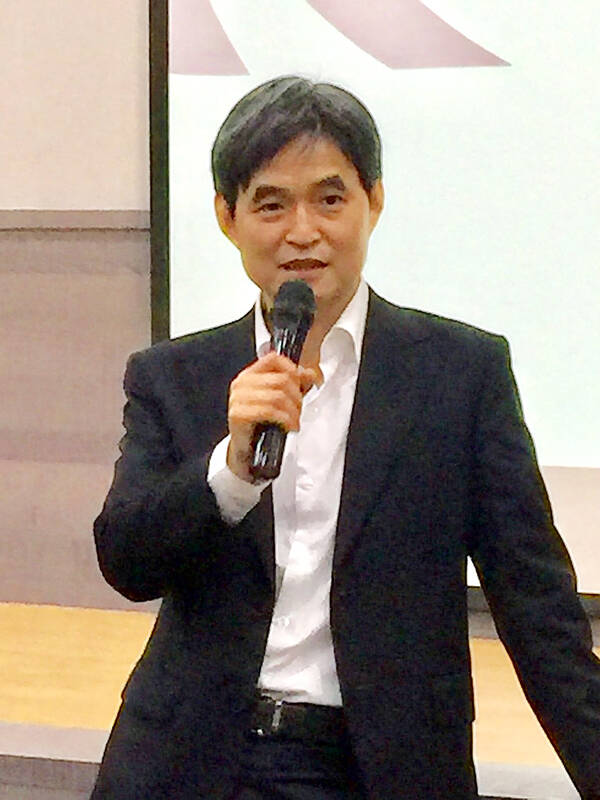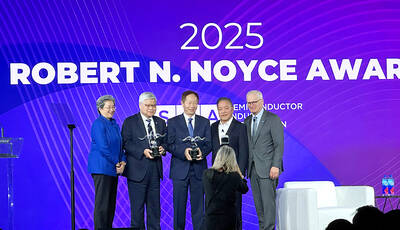Semiconductor component distributor WT Microelectronics Co (文曄) plans to fully acquire Canadian rival Future Electronics Inc in a US$3.8 billion deal, the company said yesterday.
If approved by regulators in Taiwan and abroad in the first half of next year, the transaction would be the largest since Micron Technology Inc absorbed DRAM chipmaker Inotera Memories Inc (華亞科技) for NT$132.6 billion in 2016.
WT Microelectronics expects the deal to expand its reach to the US and European markets while broadening its product offerings and customer coverage, as both companies complement each other in terms of customer bases, product portfolios and geographical deployments, it said.

PHOTO: GRACE HUNG, TAIPEI TIMES
“The acquisition marks a milestone for WT Microelectronics in expanding our global footprint,” chairman Eric Cheng (鄭文宗) told a news conference in Taipei yesterday.
WT Microelectronics’ deal would close its competitive gap with the world’s two largest semiconductor component suppliers, Arrow Electronics Inc and Avenet Inc, Cheng said, adding that the merged entity would have annual revenue surpassing US$24 billion.
WT Microelectronics distributes more than 10,000 products to Asian countries, while Future Electronics offers as much as 150,000 products to customers in regions from Europe and America to Asia, he said.
“The deal would virtually double WT Microelectronics’ customer base,” he said.
The company aims to improve its geographic diversification and reduce its reliance on Asian market, Cheng said, expecting revenue contribution from Asia to account for 57 percent of the total, with 16 percent from Europe and 27 percent from the US.
Last year, 67 percent of Future Electronics’ revenue came from higher-margin components used in industrial, automotive and communications devices, whereas WT Microelectronics only had a 35 percent revenue contribution from those three segments, Cheng said.
That allowed Future Electronics to deliver a better gross margin of 20.1 percent compared with 3.5 percent for WT Microelectronics, he said, while expecting that the company’s profitability and revenue to see a significant enhancement within the first year with the Canadian firm.
Montreal-based Future Electronics manages 170 operations in 47 countries, and has 5,200 employees worldwide. The company would operate independently after the deal has been closed next year.
WT Microelectronics plans to use a loan from DBS Bank Ltd and proceeds from the issuance of 1.35 billion special shares to fund the deal.

Shiina Ito has had fewer Chinese customers at her Tokyo jewelry shop since Beijing issued a travel warning in the wake of a diplomatic spat, but she said she was not concerned. A souring of Tokyo-Beijing relations this month, following remarks by Japanese Prime Minister Sanae Takaichi about Taiwan, has fueled concerns about the impact on the ritzy boutiques, noodle joints and hotels where holidaymakers spend their cash. However, businesses in Tokyo largely shrugged off any anxiety. “Since there are fewer Chinese customers, it’s become a bit easier for Japanese shoppers to visit, so our sales haven’t really dropped,” Ito

The number of Taiwanese working in the US rose to a record high of 137,000 last year, driven largely by Taiwan Semiconductor Manufacturing Co’s (TSMC, 台積電) rapid overseas expansion, according to government data released yesterday. A total of 666,000 Taiwanese nationals were employed abroad last year, an increase of 45,000 from 2023 and the highest level since the COVID-19 pandemic, data from the Directorate-General of Budget, Accounting and Statistics (DGBAS) showed. Overseas employment had steadily increased between 2009 and 2019, peaking at 739,000, before plunging to 319,000 in 2021 amid US-China trade tensions, global supply chain shifts, reshoring by Taiwanese companies and

Taiwan Semiconductor Manufacturing Co (TSMC, 台積電) received about NT$147 billion (US$4.71 billion) in subsidies from the US, Japanese, German and Chinese governments over the past two years for its global expansion. Financial data compiled by the world’s largest contract chipmaker showed the company secured NT$4.77 billion in subsidies from the governments in the third quarter, bringing the total for the first three quarters of the year to about NT$71.9 billion. Along with the NT$75.16 billion in financial aid TSMC received last year, the chipmaker obtained NT$147 billion in subsidies in almost two years, the data showed. The subsidies received by its subsidiaries —

Taiwan Semiconductor Manufacturing Co (TSMC) Chairman C.C. Wei (魏哲家) and the company’s former chairman, Mark Liu (劉德音), both received the Robert N. Noyce Award -- the semiconductor industry’s highest honor -- in San Jose, California, on Thursday (local time). Speaking at the award event, Liu, who retired last year, expressed gratitude to his wife, his dissertation advisor at the University of California, Berkeley, his supervisors at AT&T Bell Laboratories -- where he worked on optical fiber communication systems before joining TSMC, TSMC partners, and industry colleagues. Liu said that working alongside TSMC